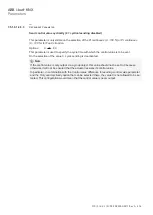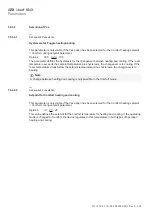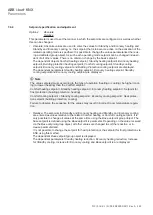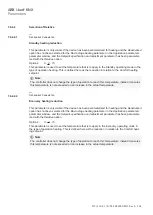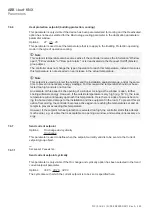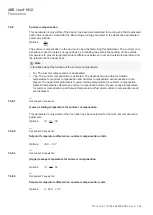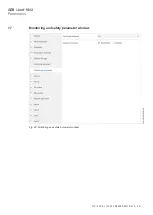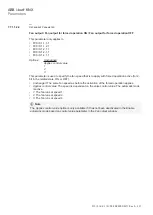
ABB i-bus
®
KNX
Parameters
FCC/S 1.X.X.1 | 2CDC 508 200 D0211 Rev A 228
7.6.4.2.5
—
Dependent Parameter
Base setpoint is
This parameter is only visible if the
Setpoint specification and adjustment
parameter has been pa-
rameterized with the
Relative
option.
Options:
Comfort heating setpoint
Comfort cooling setpoint
Mean value between Comfort heating and cooling
If the device has been configured only for the type of operation heating or the type of operation
cooling, the base setpoint is automatically the same as the Comfort setpoint for this stage and can
also not be changed.
This parameter is used to define which value corresponds to the base setpoint. It is possible to
change the setpoints parameterized for Comfort, Standby and Economy via the KNX bus using the
base setpoint. Depending on the option selected, the new base setpoint changes the value se-
lected directly. All other values are changed according to their relative distance from this value.
The values parameterized are overwritten with this change.
Note
It is not possible to change the setpoints for frost protection and heat protection using the base
setpoint.
If the basic-stage heating or the basic-stage cooling has been deactivated, the base setpoint is
fixed to the other comfort value for the existing type of operation.
7.6.5
Setpoint for frost protection (building protection, heating)
This parameter is only visible if the device has been parameterized for heating and the
Deactivated
option has not been selected for the
Basic-stage heating
parameter in the
Application parameters
parameter window.
Options:
5…7…15
This parameter is used to set the temperature that is to apply in the Building Protection operating
mode in the type of operation heating.
Note
This setpoint temperature also becomes active if the controller receives the information "Window
open", or is deactivated via the
Request On/Off (Master)
group object.
The controller does not change the type of operation to reach this temperature, instead it ensures
this temperature is not dropped below on a reduction in the actual temperature.
Note
This setpoint is used to protect the building and the installation against damage, and at the same
time to prevent unnecessary energy wastage. For this reason the temperature should not be se-
lected too low, and also not too high.
An example of this aspect is the opening of a window: As long as the window is open, further
heating will waste energy. However, if the outside temperature is very low (e.g. 0 °C), the room
temperature will continuously approach this temperature. Here there is a risk of the installation
freezing and also frost damage to the equipment in the room. To prevent this situation from aris-
ing, the controller becomes active again on reaching the temperature set and attempts to prevent
dropping below this temperature.
However, if the setpoint for frost protection is selected too high, the controller starts this attempt
much earlier, e.g. at a time that is acceptable during normal airing, and wastes unnecessary en-
ergy.

